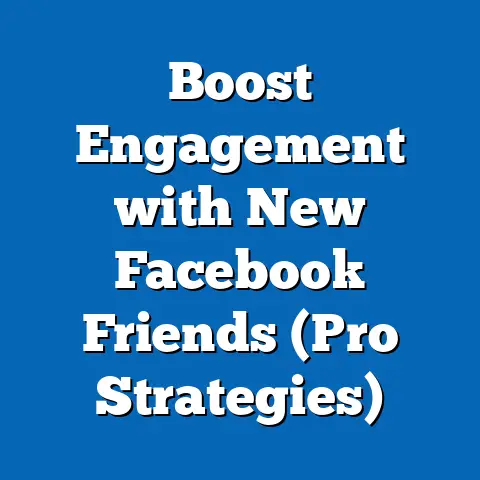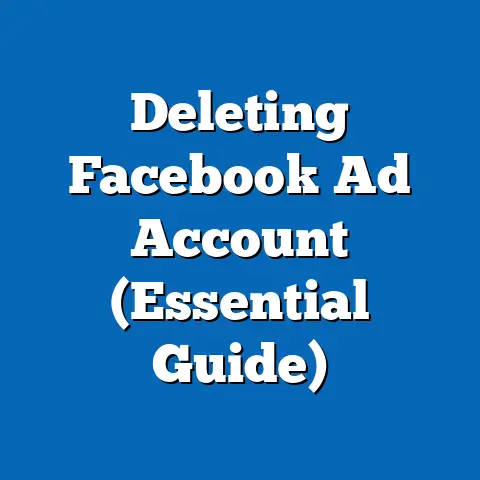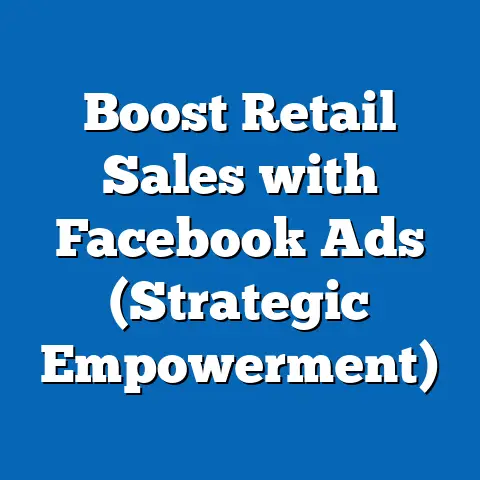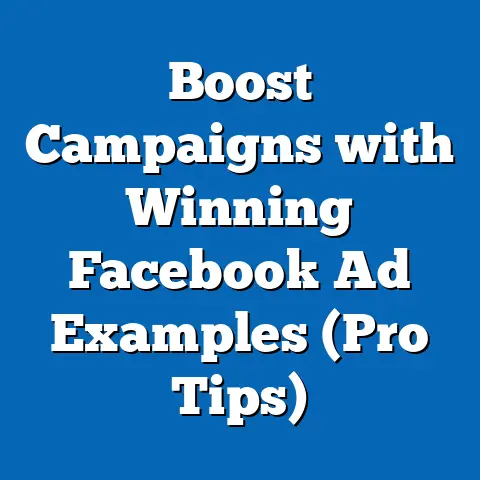Are Facebook Lead Ads GDPR Compliant? (Key Insights Revealed)
Imagine stepping into a smart home. The lights adjust to your mood, the thermostat anticipates your preferences, and your coffee starts brewing before you even reach the kitchen. This seamless convenience is powered by data – your data. Smart home devices collect information about your habits, routines, and even your location to personalize your experience. But where does all that data go? And how is it protected?
This very question is at the heart of the digital advertising landscape, where platforms like Facebook collect and utilize user data to deliver targeted ads. Facebook Lead Ads, a popular tool for businesses to generate leads directly on the platform, are no exception. But in a world increasingly concerned about data privacy, one question looms large: Are Facebook Lead Ads GDPR compliant?
The General Data Protection Regulation (GDPR) is a landmark piece of legislation that governs how companies handle the personal data of individuals in the European Union (EU). It sets a high bar for data protection and empowers individuals with significant rights over their personal information. Understanding GDPR is crucial for any business operating in the EU or targeting EU citizens, and that includes those using Facebook Lead Ads.
In this article, I’ll delve into the intricacies of Facebook Lead Ads and GDPR, exploring whether they can coexist in a way that respects user privacy and complies with the law. I’ll break down the essentials of both, examine the compliance aspects of Lead Ads, and provide key insights and takeaways for marketers navigating this complex landscape. My goal is to equip you with the knowledge to use Facebook Lead Ads effectively and ethically, ensuring you’re on the right side of data privacy regulations.
Understanding Facebook Lead Ads
Facebook Lead Ads are a powerful tool for businesses looking to generate leads directly within the Facebook platform. Instead of sending users to an external landing page, Lead Ads allow them to submit their information directly through a form that pops up within their Facebook feed. This streamlined process offers a frictionless experience, increasing the likelihood of conversion.
For marketers, Lead Ads offer several key advantages:
- Customizable Forms: I can tailor the forms to collect specific information relevant to my business, such as name, email address, phone number, job title, and more.
- Instant Information Collection: Facebook automatically populates the form with information users have already provided on the platform, further simplifying the submission process.
- CRM Integration: Lead Ads can be seamlessly integrated with customer relationship management (CRM) systems, allowing me to automatically capture and manage the leads generated.
Lead Ads have become a staple in the digital marketing arsenal, offering a convenient and effective way to connect with potential customers. Their popularity stems from their ability to deliver high-quality leads without disrupting the user experience. Businesses across various industries, from real estate to education, have successfully leveraged Lead Ads to grow their customer base. I’ve personally seen them work wonders for local businesses trying to capture interest in new services or promotions.
However, with this convenience comes responsibility. Collecting personal data, even through a seemingly simple form, requires careful consideration of data privacy regulations, particularly GDPR.
The Essentials of GDPR
The General Data Protection Regulation (GDPR) is a regulation in EU law on data protection and privacy in the European Economic Area (EEA). It also addresses the transfer of personal data outside the EU and EEA areas. Its primary aim is to give individuals control over their personal data and to simplify the regulatory environment for international business by unifying the regulation within the EU.
GDPR is built on several key principles:
- Lawfulness, Fairness, and Transparency: Data processing must be lawful, fair, and transparent to the data subject. This means informing users about how their data will be used in clear and understandable language.
- Purpose Limitation: Data can only be collected for specified, explicit, and legitimate purposes. You can’t collect data for one reason and then use it for another without obtaining new consent.
- Data Minimization: Only collect the data that is necessary for the specified purpose. Avoid collecting excessive or irrelevant information.
- Accuracy: Ensure that the data you collect is accurate and kept up to date.
- Storage Limitation: Data should be kept for no longer than necessary for the purposes for which it was collected.
- Integrity and Confidentiality: Implement appropriate security measures to protect data against unauthorized access, loss, or destruction.
GDPR also grants individuals several key rights:
- Right to Access: Individuals have the right to access their personal data and to know how it is being processed.
- Right to Rectification: Individuals have the right to correct inaccurate or incomplete personal data.
- Right to Erasure (Right to be Forgotten): Individuals have the right to have their personal data erased under certain circumstances.
- Right to Restrict Processing: Individuals have the right to restrict the processing of their personal data under certain circumstances.
- Right to Data Portability: Individuals have the right to receive their personal data in a structured, commonly used, and machine-readable format.
- Right to Object: Individuals have the right to object to the processing of their personal data under certain circumstances.
Failure to comply with GDPR can result in hefty fines, up to €20 million or 4% of annual global turnover, whichever is higher. Beyond the financial penalties, non-compliance can also damage your reputation and erode customer trust. I’ve seen firsthand how negative press surrounding data breaches and privacy violations can severely impact a brand’s image.
GDPR is not just a legal requirement; it’s a fundamental shift towards prioritizing user privacy and data protection. Businesses that embrace these principles and build trust with their customers are more likely to succeed in the long run.
Are Facebook Lead Ads GDPR Compliant?
The million-dollar question: Can you use Facebook Lead Ads and remain GDPR compliant? The short answer is yes, but it requires careful planning and execution. Facebook, as a platform, has taken steps to align its advertising tools with GDPR regulations, but the responsibility ultimately falls on the advertiser to ensure compliance.
Here’s a breakdown of the key areas to consider:
-
User Consent: GDPR mandates that consent must be freely given, specific, informed, and unambiguous. This means you need to obtain explicit consent from users before collecting their data through Lead Ads.
- Clear and Concise Language: The consent language in your Lead Ad form must be clear, concise, and easy to understand. Avoid using jargon or legalese. Explain exactly what data you’re collecting and how you plan to use it. I always recommend testing different consent messages to see which ones resonate best with your audience.
- Affirmative Action: Consent must be given through an affirmative action, such as checking a box. Pre-ticked boxes or implied consent are not valid under GDPR.
- Separate Consent for Different Purposes: If you plan to use the data for multiple purposes (e.g., sending marketing emails and sharing it with a third-party partner), you need to obtain separate consent for each purpose.
-
Data Processing: As a data controller, you are responsible for determining the purposes and means of processing personal data collected through Lead Ads. Facebook acts as a data processor, providing the platform and tools to collect and process the data on your behalf.
-
Data Processing Agreement (DPA): Ensure you have a Data Processing Agreement (DPA) in place with Facebook. This agreement outlines the responsibilities of both parties in protecting the data.
- Data Security: Implement appropriate security measures to protect the data you collect from unauthorized access, loss, or destruction. This includes encrypting data, using strong passwords, and regularly updating your security systems.
- Data Minimization: Only collect the data that is necessary for the specified purpose. Avoid collecting excessive or irrelevant information. I’ve learned that asking for too much information can actually deter users from completing the form.
-
User Rights: GDPR grants individuals several rights regarding their personal data, including the right to access, rectification, erasure, and portability. You need to be prepared to respond to requests from users who wish to exercise these rights.
-
Accessibility: Make it easy for users to access and manage their data. Provide clear instructions on how they can request access, rectification, or erasure of their data.
- Timely Response: Respond to user requests in a timely manner. GDPR requires you to respond to requests within one month.
- Data Portability: Be prepared to provide users with their data in a structured, commonly used, and machine-readable format.
-
Transparency: Be transparent about how you collect, use, and share personal data. Provide a clear and easily accessible privacy policy on your website.
-
Privacy Policy: Your privacy policy should explain what data you collect, how you use it, who you share it with, and how users can exercise their rights.
- Link to Privacy Policy: Include a link to your privacy policy in your Lead Ad form.
- Retention Policy: Define a clear retention policy for the data you collect. How long will you keep the data? What will you do with it when it’s no longer needed?
User Consent: GDPR mandates that consent must be freely given, specific, informed, and unambiguous. This means you need to obtain explicit consent from users before collecting their data through Lead Ads.
- Clear and Concise Language: The consent language in your Lead Ad form must be clear, concise, and easy to understand. Avoid using jargon or legalese. Explain exactly what data you’re collecting and how you plan to use it. I always recommend testing different consent messages to see which ones resonate best with your audience.
- Affirmative Action: Consent must be given through an affirmative action, such as checking a box. Pre-ticked boxes or implied consent are not valid under GDPR.
- Separate Consent for Different Purposes: If you plan to use the data for multiple purposes (e.g., sending marketing emails and sharing it with a third-party partner), you need to obtain separate consent for each purpose.
-
Data Processing: As a data controller, you are responsible for determining the purposes and means of processing personal data collected through Lead Ads. Facebook acts as a data processor, providing the platform and tools to collect and process the data on your behalf.
-
Data Processing Agreement (DPA): Ensure you have a Data Processing Agreement (DPA) in place with Facebook. This agreement outlines the responsibilities of both parties in protecting the data.
- Data Security: Implement appropriate security measures to protect the data you collect from unauthorized access, loss, or destruction. This includes encrypting data, using strong passwords, and regularly updating your security systems.
- Data Minimization: Only collect the data that is necessary for the specified purpose. Avoid collecting excessive or irrelevant information. I’ve learned that asking for too much information can actually deter users from completing the form.
-
User Rights: GDPR grants individuals several rights regarding their personal data, including the right to access, rectification, erasure, and portability. You need to be prepared to respond to requests from users who wish to exercise these rights.
-
Accessibility: Make it easy for users to access and manage their data. Provide clear instructions on how they can request access, rectification, or erasure of their data.
- Timely Response: Respond to user requests in a timely manner. GDPR requires you to respond to requests within one month.
- Data Portability: Be prepared to provide users with their data in a structured, commonly used, and machine-readable format.
-
Transparency: Be transparent about how you collect, use, and share personal data. Provide a clear and easily accessible privacy policy on your website.
-
Privacy Policy: Your privacy policy should explain what data you collect, how you use it, who you share it with, and how users can exercise their rights.
- Link to Privacy Policy: Include a link to your privacy policy in your Lead Ad form.
- Retention Policy: Define a clear retention policy for the data you collect. How long will you keep the data? What will you do with it when it’s no longer needed?
Data Processing: As a data controller, you are responsible for determining the purposes and means of processing personal data collected through Lead Ads. Facebook acts as a data processor, providing the platform and tools to collect and process the data on your behalf.
Data Processing Agreement (DPA): Ensure you have a Data Processing Agreement (DPA) in place with Facebook. This agreement outlines the responsibilities of both parties in protecting the data.
User Rights: GDPR grants individuals several rights regarding their personal data, including the right to access, rectification, erasure, and portability. You need to be prepared to respond to requests from users who wish to exercise these rights.
Accessibility: Make it easy for users to access and manage their data. Provide clear instructions on how they can request access, rectification, or erasure of their data.
Transparency: Be transparent about how you collect, use, and share personal data. Provide a clear and easily accessible privacy policy on your website.
Privacy Policy: Your privacy policy should explain what data you collect, how you use it, who you share it with, and how users can exercise their rights.
I’ve seen several brands successfully navigate GDPR compliance while using Facebook Lead Ads. One example is a European e-commerce company that implemented a double opt-in process for all leads generated through Lead Ads. This means that after submitting the form, users receive an email asking them to confirm their consent to receive marketing communications. This extra step ensures that the consent is truly freely given and unambiguous.
Another example is a financial services company that invested in a robust data management system to track and manage user consent. This system allows them to easily respond to user requests to access, rectify, or erase their data.
These examples highlight the importance of taking a proactive approach to GDPR compliance. It’s not enough to simply rely on Facebook’s platform features; you need to implement your own policies and procedures to ensure that you’re meeting your obligations under GDPR.
Key Insights and Takeaways
Navigating the intersection of Facebook Lead Ads and GDPR can feel like traversing a minefield. However, by understanding the key principles and implementing the right practices, you can use Lead Ads effectively and ethically. Here are some key insights and takeaways:
- GDPR Compliance is Not Optional: GDPR is not just a suggestion; it’s a legal requirement for any business operating in the EU or targeting EU citizens. Ignoring GDPR can result in significant fines and reputational damage.
- Consent is King: Obtaining valid consent is paramount. Ensure that your consent language is clear, concise, and easy to understand. Use affirmative action to obtain consent and provide separate consent options for different purposes.
- Transparency Builds Trust: Be transparent about how you collect, use, and share personal data. Provide a clear and easily accessible privacy policy on your website.
- Data Management is Crucial: Invest in a robust data management system to track and manage user consent and to respond to user requests in a timely manner.
- Stay Informed: GDPR is an evolving landscape. Stay informed about the latest regulations and best practices. Consult with legal counsel if you have any questions or concerns.
- Prioritize User Privacy: Ultimately, GDPR is about protecting user privacy. By prioritizing user privacy, you can build trust with your customers and create a more sustainable business.
I’ve learned that approaching GDPR not as a burden, but as an opportunity, can be a game-changer. By embracing data privacy principles, you can differentiate yourself from competitors and build stronger relationships with your customers.
The challenges of GDPR compliance are undeniable, but the opportunities are even greater. Businesses that prioritize transparency, consent, and data management are more likely to succeed in the long run.
As you adapt to GDPR, consider the potential for innovation. Explore new ways to engage with your audience in a privacy-conscious manner. Experiment with different ad formats and targeting strategies. By embracing creativity and innovation, you can continue to leverage Facebook Lead Ads for lead generation while respecting user privacy.
Conclusion
In conclusion, while Facebook Lead Ads can be a powerful tool for generating leads, it’s crucial to remember that GDPR compliance is paramount. By understanding the key principles of GDPR, obtaining valid consent, and implementing robust data management practices, you can use Lead Ads effectively and ethically.
The balance between effective marketing strategies and the ethical responsibility to protect user data is a delicate one. However, it’s a balance that businesses must strike in order to succeed in today’s privacy-conscious world.
As the digital advertising landscape continues to evolve, staying vigilant in understanding your obligations under GDPR is essential. Emerging trends and technologies, such as privacy-enhancing technologies (PETs) and zero-party data collection, may further shape the landscape in the years to come.
The future of digital advertising is one where privacy and personalization coexist. By embracing data privacy principles and building trust with your customers, you can create a more sustainable and successful business. So, go forth, use Facebook Lead Ads wisely, and champion the cause of data privacy!





